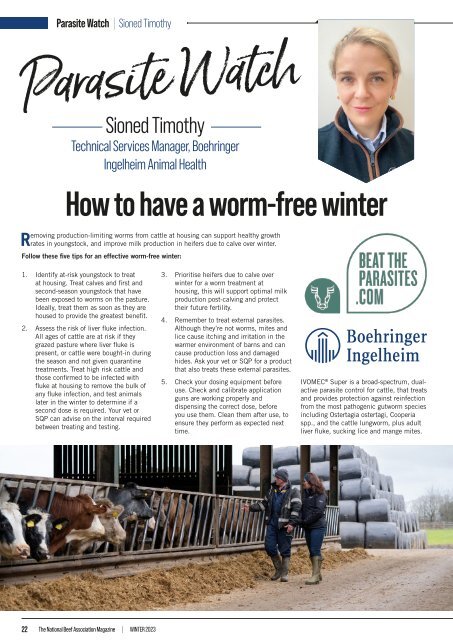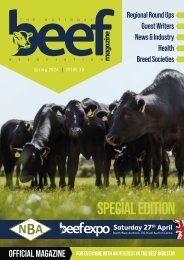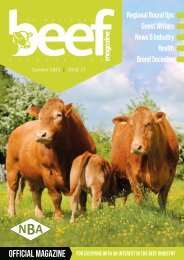NBA Winter Magazine_2023_
For everyone with an interest in the British Beef Industry
For everyone with an interest in the British Beef Industry
Create successful ePaper yourself
Turn your PDF publications into a flip-book with our unique Google optimized e-Paper software.
Parasite Watch | Sioned Timothy<br />
Parasite Watch<br />
Sioned Timothy<br />
Technical Services Manager, Boehringer<br />
Ingelheim Animal Health<br />
How to have a worm-free winter<br />
Removing production-limiting worms from cattle at housing can support healthy growth<br />
rates in youngstock, and improve milk production in heifers due to calve over winter.<br />
Follow these five tips for an effective worm-free winter:<br />
1. Identify at-risk youngstock to treat<br />
at housing. Treat calves and first and<br />
second-season youngstock that have<br />
been exposed to worms on the pasture.<br />
Ideally, treat them as soon as they are<br />
housed to provide the greatest benefit.<br />
2. Assess the risk of liver fluke infection.<br />
All ages of cattle are at risk if they<br />
grazed pasture where liver fluke is<br />
present, or cattle were bought-in during<br />
the season and not given quarantine<br />
treatments. Treat high risk cattle and<br />
those confirmed to be infected with<br />
fluke at housing to remove the bulk of<br />
any fluke infection, and test animals<br />
later in the winter to determine if a<br />
second dose is required. Your vet or<br />
SQP can advise on the interval required<br />
between treating and testing.<br />
3. Prioritise heifers due to calve over<br />
winter for a worm treatment at<br />
housing, this will support optimal milk<br />
production post-calving and protect<br />
their future fertility.<br />
4. Remember to treat external parasites.<br />
Although they’re not worms, mites and<br />
lice cause itching and irritation in the<br />
warmer environment of barns and can<br />
cause production loss and damaged<br />
hides. Ask your vet or SQP for a product<br />
that also treats these external parasites.<br />
5. Check your dosing equipment before<br />
use. Check and calibrate application<br />
guns are working properly and<br />
dispensing the correct dose, before<br />
you use them. Clean them after use, to<br />
ensure they perform as expected next<br />
time.<br />
IVOMEC ® Super is a broad-spectrum, dualactive<br />
parasite control for cattle, that treats<br />
and provides protection against reinfection<br />
from the most pathogenic gutworm species<br />
including Ostertagia ostertagi, Cooperia<br />
spp., and the cattle lungworm, plus adult<br />
liver fluke, sucking lice and mange mites.<br />
22 The National Beef Association <strong>Magazine</strong> | WINTER <strong>2023</strong>






